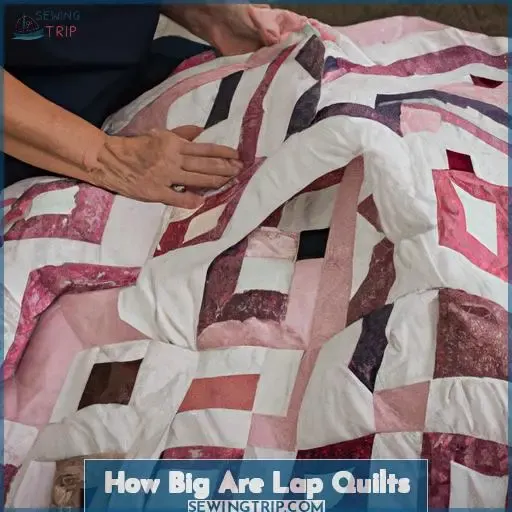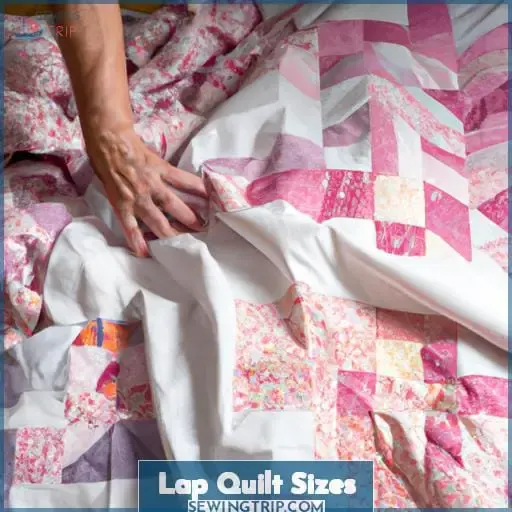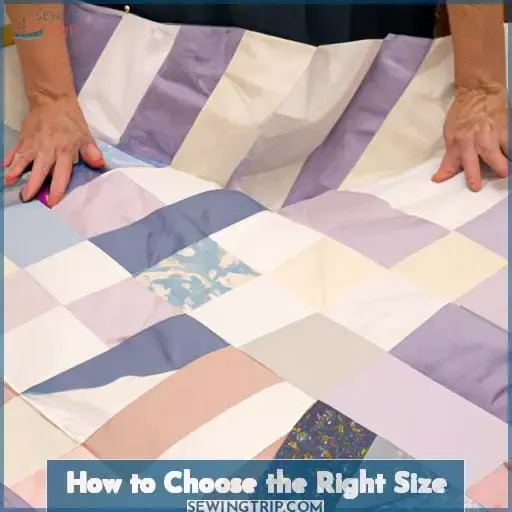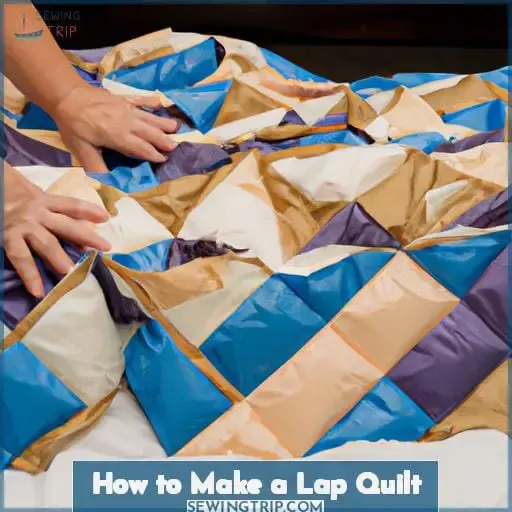This site is supported by our readers. We may earn a commission, at no cost to you, if you purchase through links.
Welcome to the world of quilting! Quilts are functional pieces that bring warmth and comfort into our homes. Lap quilts make great additions; they can be used as stylish throws, cozy blankets, or even wall hangings. But how big should lap quilts be?
In this article we explore all aspects related to lap quilt sizes, so you can create the perfect piece for your space. We’ll take you on a journey through understanding proper measurements and techniques to craft an heirloom-quality masterpiece.
Let’s get started!
Table Of Contents
What is a Lap Quilt?

Lap quilts are a cozy and comforting way to show someone you care. They come in a variety of sizes and can be tailored to fit the needs of any recipient.
Typically, lap quilts are smaller than throw quilts. They measure between 36-40 inches wide by 40-50 inches long. Baby or crib quilts may also be used as lap blankets for wheelchairs. These should measure 35×46 inches.
Quilting techniques like fabric selection, pattern selection, needlework tips, and color combinations will all play into deciding the size best suited for your project. Ultimately, it’s up to the individual preference, but having an understanding of common measurements is essential when starting out on this crafty journey!
Lap Quilt Sizes

Lap quilts are a great way to add comfort and coziness to any space. They range from 36-50 inches in width and length, perfect for snuggling up with! Popular sizes range between 36-40 inches wide by 40-50 inches long.
Quilt patterns can vary depending on the look you’re going for. Binding methods, thread types used, color schemes, and fabric types all affect the size.
For larger projects such as twin-size or queen/king bedding sets, you should take overhang allowance into consideration. Allow extra material around the edges so blankets hang off sides. For throw sized blankets, they usually measure 64×86. It’s helpful knowing these dimensions before starting your project so you don’t end up with something too large or too small when finished!
How to Choose the Right Size

Choosing the right size for your lap quilt is essential. Take measurements with a tape measure before starting to determine how much fabric to buy and what size to make the finished product. Lap blankets typically range from 36-50 inches square or rectangular, while queen-size quilts are around 99×108 inches.
Consider colors for designing patterns, different techniques for sewing and piecing together sections of material like sashing or borders, and which type of batting to use based on climate conditions.
Get inspiration from online tutorials, photos on Pinterest, family heirlooms, etc. But get an accurate measurement first by measuring bed space, then settle on design elements and fabrics so the final product fits just right.
How to Make a Lap Quilt
Making a lap quilt is an easy project that requires minimal fabric and can be done in no time!
To get started, measure out the squares and sew them together horizontally and then vertically.
Make a quilt sandwich with batting and backing fabric.
After free motion or straightforward design quilting it all together, bind your finished product for a cozy lap blanket.
Fabric Requirements
Once you’ve settled on the size and design of your lap quilt, it’s time to choose the fabric that will bring your project to life! There are plenty of options. Consider wall hangings or table runners for pattern selection. Choose colors and patterns from throw-sized quilts or larger sizes like twin beds. Think about special techniques like applique work to add texture and dimension. With all these choices available u2014 design ideas, color options, fabric types u2014 you can create a one-of-a kind piece!
Step 1: Cut the Squares
To get started making your lap quilt, the first step is to cut out the fabric squares that will make up its design. Making wise choices of fabrics for both the top and backing can greatly influence how successful your finished project looks. Selecting patterns with a combination of light and dark colors or bold designs makes it more interesting visually, while choosing solid colors gives it a classic look.
Quilt batting should be chosen based on thickness level – either low loft or high loft depending on what type of use you intend for it; keep in mind this may require additional time to sew together properly due to their bulkiness.
Remember, much like sizing place mats or creating full-size quilts for beds, lap quilts have varying sizes too! Your grandson’s crib may call for an extra small size whereas larger dimensions are needed when gifting one as an adult throw blanket. Familiarize yourself with various measurements found online before starting any project so you know exactly what kind of space you’ll need when cutting each piece out from selected fabric rolls.
Step 2: Sew the Horizontal Squares Together
Now it’s time to sew together the pieces of fabric and create your beautiful lap quilt! Start by laying out all 80 squares horizontally in rows. This is key for making sure you get a balanced, even design. Use a 1/4 inch seam allowance when sewing each row together – this’ll prevent bunching or puckering, which can change the measurements and affect how well it fits.
If you’re feeling creative, add some embellishments like applique or embroidery. This makes creating an eye-catching color scheme easier. Now that everything’s pieced together correctly, move onto adding backing fabric so your king size quilts are ready for binding with no trouble.
Finish up according to the instructions from our free printable measurement chart and lap quilt patterns guide. Finish off with binding per usual, then admire your handiwork proudly!
Step 3: Sew the Rows Together
Once you’ve laid out all 80 squares of fabric, it’s time to stitch them together and create your beautiful lap quilt! Select the materials: batting size should be 40×50 inches, backing fabric requires 1 1/2 yards, binding requires 1/3 yard.
Sizing for lap quilts should be 36 x 45. Quilting techniques are important too; piecing methods include sewing horizontal squares together with a ¼ inch seam allowance before rows are sewn together and pressed flat.
Color coordination is essential in making sure your masterpiece looks great!
Step 4: Make the Quilt Sandwich and Quilt It
Now that you’ve pieced together your lap quilt, it’s time to make the quilt sandwich and start quilting! Creative design decisions and technical skill are both needed. The quilting technique depends on the size of your project. You can customize the color scheme and binding for your preference.
For beginners, it’s best to use standard sizes, e.g. 36 x 45 inches, for a proper fit. Edge-quilting gives a nice finish, but it may take longer if done by hand. With practice, it’ll become mastered quickly!
Good luck and happy sewing!
Step 5: Bind the Quilt
Now that you’ve finished quilting your lap blanket, it’s time to bind the edges for a beautiful finish! Designing borders, adding applique and choosing threads are all important steps.
But before setting out on those tasks, it’s essential to understand the basics of quilt sizes–especially when deciding between king-size bed coverings versus standard bed-sized or twin-sized ones.
Lap quilts usually measure 36×45, but can vary from 30×46 up to 40u201d x 50. Keep in mind that these measurements should fit snugly onto a lap; if they don’t, consider picking fabrics with an eye towards creating larger squares than usual. That way you’ll have warmth and comfort without being cramped by small pieces.
With this knowledge, you’ll have no trouble making sure your final product looks just right!
Frequently Asked Questions (FAQs)
What are the benefits of lap quilts?
Lap quilts are a great way to add comfort, style and warmth to your home. They come in different sizes and common measurements to fit any space.
They offer health advantages like reducing stress levels and improving sleep quality. Plus, they give design considerations like color schemes and quilting techniques that best suit your needs. With the right size lap quilt tailored for you, it’ll make a difference when it comes to finding a good place of relaxation!
What types of fabrics are most suitable for lap quilts?
When selecting fabric for lap quilts, a smart approach is to consider the type of quilt being made. For traditional throw size lap quilts meant for beds or toddler beds, look for fabrics with higher thread counts that are durable and easy to care for. A variety of suggested patterns also exist from which you can choose depending on your desired outcome and design preference.
When creating smaller wall hangings or place mats as gifts, lighter-weight fabrics such as cotton voile may be more suitable since they’ll produce a softer feel once completed.
Ultimately, the right selection of fabric should reflect your vision while providing comfort and durability when finished!
What is the best way to quilt a lap quilt?
Creating a lap quilt is the perfect project for any beginner quilter. To do it right, you must understand the different fabric choices, thread types, batting options and stitch lengths available to you.
A smart approach would be to start with a free pattern found online that offers all of these elements in one place. Then choose fabrics based on your desired outcome u2014 such as lightweight cottons or woolen flannels u2014 and layer them together using layering techniques specific to lap quilts.
As far as stitching goes, use shorter stitches than those used on larger projects since this will make for an even finish that’s better suited to small spaces like lap blankets!
Is there a standard size for lap quilts?
Investigating the truth of a theory, it’s important to understand that while there is no exact science or general rule of thumb when it comes to lap quilts, common measurements are a good starting point.
When considering the different attributes of lap quilts – such as quilt patterns, color choices, thread selection and gift ideas – understanding their significance can help you select the smartest approach for your own project. With machine quilting being an option if desired, familiarizing yourself with popular sizes will ensure your finished project fits perfectly on whatever space you intend to put it in; typically between 36-40 inches wide and 40-50 inches long (or 35×46 for wheelchair use).
Ultimately though, size should be left up to interpretation as long as overhang allows for proper fit!
What other uses can lap quilts have?
Lap quilts can offer more than just comfort and warmth in a hospital setting. They range from 36-40 inches wide and 40-50 inches long, with design options from decorative styles to accessorizing. So don’t be afraid to explore all of your possibilities – they may surprise you with their versatility!
At the various quilt shops across the country, you’ll find something unique no matter what your needs are. Standard quilt sizes and creative patterns make them perfect for sprucing up any space.
Conclusion
In conclusion, lap quilts are a wonderful way to bring comfort to those in need. They can be customized to fit a variety of sizes and purposes. Just like a tailor, quilters can measure and craft the perfect blanket for any individual.
As long as you have the right measurements, the process of creating a lap quilt is like a dance. With each stitch, your quilt comes to life.
With a little bit of patience and practice, you can make a beautiful, handmade lap quilt.







